Vietnam Food Specialties offer a captivating exploration into the heart and soul of the country. Far beyond the widely recognized icons of phở and bánh mì, Vietnamese cuisine unfolds as a vibrant symphony of tastes, textures, and aromas. It’s a culinary landscape where fresh ingredients, regional nuances, and centuries of history converge on the plate, telling stories of resilience, tradition, and daily life.
As a traveler and food enthusiast, delving into Vietnam Food Specialties is non-negotiable. Every dish is a narrative, a window into local culture and the ingenious use of abundant local produce. The Vietnamese people’s deep connection to food is palpable; cooks meticulously craft meals that reflect the unique character and resources of their region, creating distinct culinary identities across the nation.
From the subtle elegance of the North, where delicate flavors reign supreme, to the bold, spicy, and generous portions of the Central region, and the sweeter profiles favored in the South, the culinary journey through Vietnam is incredibly diverse. No matter where your travels take you in this fascinating country, you are guaranteed to eat exceptionally well, discovering new favorites among the rich array of Vietnam Food Specialties.
A Taste of Place: Regional Flavors of Vietnam
Vietnamese cuisine is characterized by its regional diversity, a reflection of geography, climate, and historical influences. Understanding these regional distinctions enhances the appreciation of Vietnam Food Specialties. Northern Vietnamese food is often characterized by lighter, balanced flavors, less spice, and a focus on clear broths and savory elements. The food is less sweet compared to other regions.
Central Vietnam, home to the former imperial capital Hue, boasts a more complex and often spicier cuisine. Dishes are known for their vibrant colors, intricate presentation, and a wider use of chili and shrimp paste. Portions can sometimes be smaller, hinting at the refined nature of royal cuisine, though street food remains hearty.
Southern Vietnamese food is influenced by its fertile lands and proximity to the Mekong Delta. This region’s dishes are generally sweeter, incorporating coconut milk and sugar more frequently. The flavors are bold and diverse, utilizing a wider variety of herbs and spices, and often featuring seafood and tropical fruits.
Exploring Iconic Vietnam Food Specialties
The list of must-try Vietnam Food Specialties is extensive, but some dishes stand out as essential experiences for any visitor. Each one offers a unique perspective on Vietnamese culinary artistry and the country’s rich cultural tapestry. Trying these dishes is more than just eating; it’s participating in a living tradition.
Phở: Vietnam’s Iconic Noodle Soup
If there’s one dish synonymous with Vietnam, it’s Phở. This comforting noodle soup is a cornerstone of Vietnam Food Specialties. The name “phở” specifically refers to the flat rice noodles that are central to the dish. A steaming bowl typically features these delicate noodles swimming in a rich, aromatic beef or chicken broth, often accompanied by tender slices of medium-rare beef or shredded boiled chicken.
There are two main widely known regional variations. Phở Hà Nội, originating from the North, is celebrated for its remarkably clear broth, often seasoned simply with a squeeze of lemon and fiery bird’s eye chili slices. In contrast, Phở Nam (Southern style) typically has a slightly cloudier broth and is served with a generous platter of fresh herbs like bean sprouts, basil, and mint, allowing diners to customize their bowl.
Fun Things to Do in Kissimmee Florida
Where To Go In Waikiki – Your Ultimate Guide to Hawaii’s Iconic Beachfront
The Best Things to Do in Naples – Your Ultimate Italian Experience
The magic of a truly exceptional bowl of Phở lies within its broth. This flavorful foundation is traditionally simmered for hours, infused with fragrant whole spices such as star anise, cloves, and cinnamon, which impart a subtle, natural sweetness. While many outsiders view Phở as a lunch or dinner option, it is a common and beloved breakfast food for locals across Vietnam. Finding a Phở stall is easy; they are practically on every street corner.
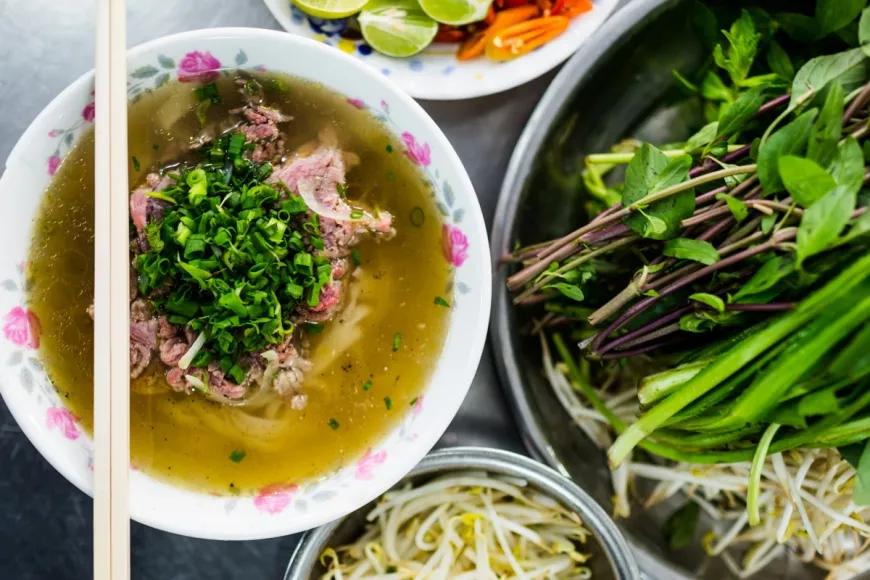 Close-up of a steaming bowl of Pho, a classic Vietnam Food Specialty with beef and herbs
Close-up of a steaming bowl of Pho, a classic Vietnam Food Specialty with beef and herbs
Try it: Pho Thin, 13 Lo Duc, Hai Ba Trung District in Hanoi or Pho Hoa, 260C Pasteur Street, District 3 in Ho Chi Minh City.
Bánh Mì: The Perfect Vietnamese Sandwich
Bánh mì is a brilliant example of how historical influences are adapted and perfected within Vietnamese cuisine, becoming a true Vietnam Food Specialty. While the baguette itself was introduced by the French, the Vietnamese have transformed it into a uniquely their own creation. The warm, crusty baguette is typically sliced open, and its soft interior is spread with rich pâté and creamy margarine.
What follows is a delightful assembly of fillings that create a symphony of textures and flavors: pickled vegetables (like carrots and daikon), fresh cilantro, savory pork belly, fluffy pork floss, and crisp cucumber slices. Taking a bite reveals the satisfying crunch of the exterior yielding to a warm, soft center packed with a complex combination of savory, tangy, and fresh elements. Bánh mì is a staple street food, offering a quick, inexpensive, and incredibly satisfying meal on the go.
 Delicious Banh Mi sandwich filled with pickled vegetables and pork, a popular Vietnam Food Specialty
Delicious Banh Mi sandwich filled with pickled vegetables and pork, a popular Vietnam Food Specialty
Try it: Banh My Phuong, 2B Phan Chau Trinh, Hoi An.
Cơm Tấm: Broken Rice with Rich Toppings
Cơm tấm, or “broken rice,” is a Vietnam Food Specialty with humble origins. Traditionally, broken rice grains were the fragments left over after processing, considered less valuable and thus consumed by farmers rather than being sold. Today, however, this dish has risen from its modest roots to become a popular and often elaborate meal, a staple for the working class and enjoyed by everyone.
While cơm tấm can be prepared in various ways, one of the most beloved versions is cơm tấm sườn nướng ốp la. This decadent preparation features a beautifully caramelized grilled pork chop served alongside a sunny-side-up fried egg, all piled atop a generous heap of the characteristic broken rice. The dish is then generously drizzled with nước chấm, a classic Vietnamese dipping sauce made from chili, fish sauce, and sugar, often finished with a touch of vibrant green onion oil.
Accompanying the main components are refreshing sides like shredded pickled carrots and daikon, crisp slices of cucumber and tomato, and a garnish of crunchy fried pork rinds and shallots. The combination of textures – the tender rice, the savory pork, the runny egg yolk, and the crispy toppings – creates a truly satisfying and flavorful experience that highlights the ingenuity of Vietnamese cooks in elevating simple ingredients into a beloved Vietnam Food Specialty.
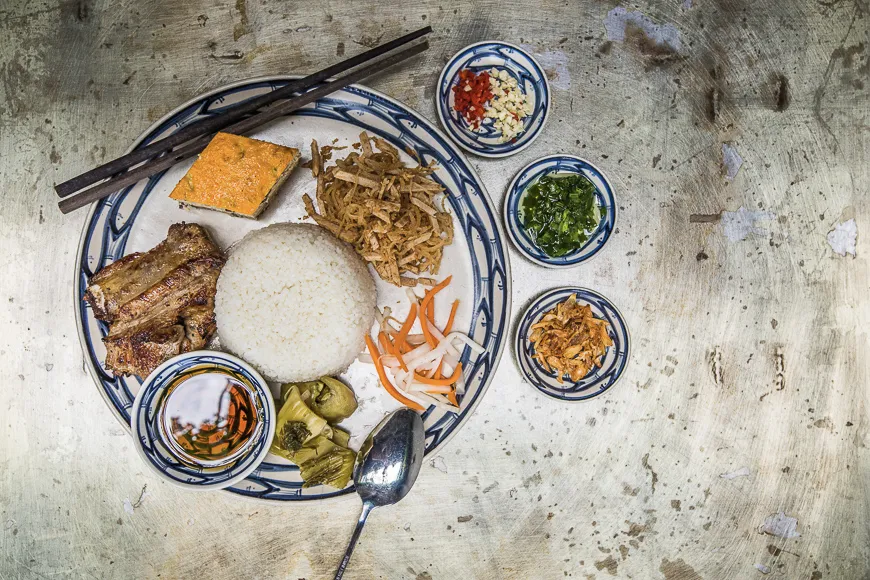 A plate of Com Tam, broken rice with grilled pork and a fried egg, a popular Vietnam Food Specialty
A plate of Com Tam, broken rice with grilled pork and a fried egg, a popular Vietnam Food Specialty
Try it: A family-operated stall on 260 Vo Van Tan, District 3, Ho Chi Minh City.
Bún Bò Huế: Spicy Beef Noodle Soup from Hue
Representing the sophisticated royal cuisine of Hue, the former imperial city, Bún Bò Huế is a powerful and flavorful Vietnam Food Specialty. Its striking appearance, particularly the vibrant red hue of the broth, immediately signals its intense flavor profile. This signature broth is the result of patiently simmering beef bones and fragrant lemongrass stalks for hours, creating a deeply aromatic and citrusy base.
Tender slices of beef shank and flash-boiled vegetables add freshness and texture to this dynamic soup. Although “bò” means beef in Vietnamese, don’t be surprised to find chả lụa, a type of Vietnamese sausage made from ham paste with a texture similar to firm tofu, lurking within the bowl. Bún Bò Huế offers a complex layering of flavors – spicy, savory, slightly sour, and herbaceous – making it a truly memorable culinary experience from Central Vietnam.
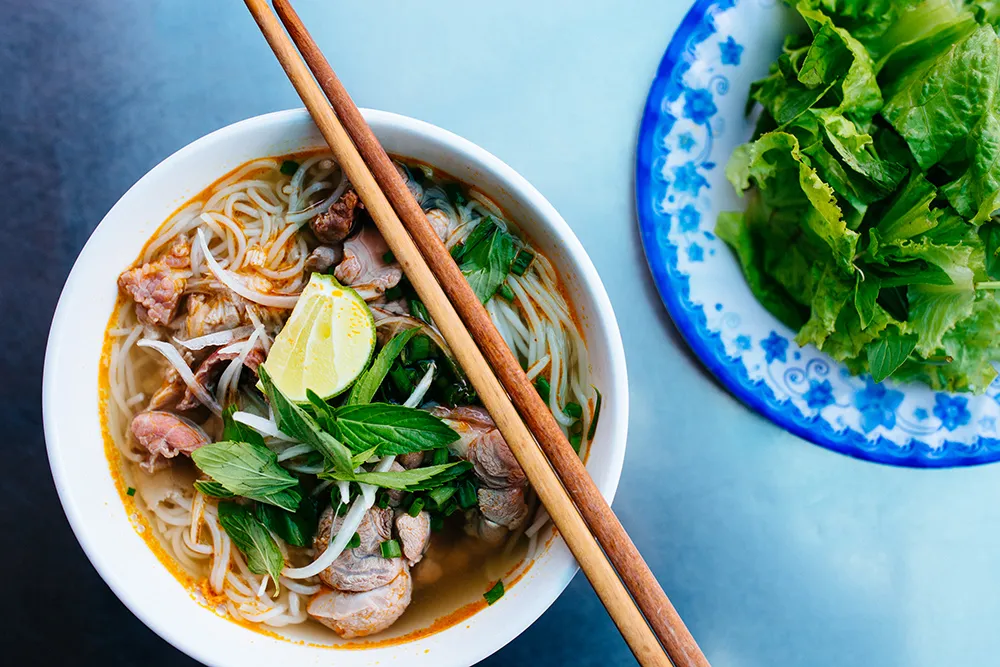 A bowl of Bun Bo Hue, a spicy beef noodle soup from Central Vietnam and a notable Vietnam Food Specialty
A bowl of Bun Bo Hue, a spicy beef noodle soup from Central Vietnam and a notable Vietnam Food Specialty
Try it: Quan Bun Bo Hue, 19 Ly Thuong Kiet Street, Hue.
Cao Lầu: Hoi An’s Unique Noodle Dish
Cao Lầu is a truly unique Vietnam Food Specialty found exclusively in the charming ancient town of Hoi An. This dish pays homage to the town’s history as a bustling coastal trading port, blending influences from various cultures, particularly Japanese and Chinese, into a distinctively Vietnamese creation. The foundation of Cao Lầu is its special noodle.
These thick, chewy noodles are said to possess a unique texture, often compared to Japanese udon. Slices of flavorful Chinese barbecued pork (xá xíu) are fanned out over the noodles, which are then dressed with a rich, spiced broth – just enough to coat the ingredients, not fully submerge them like a soup. Fresh herbs and crunchy crushed pork cracklings are added for garnish and texture. Legend has it that authentic Cao Lầu noodles must be made using water from the ancient Ba Le well in Hoi An, rumored to have special properties that give the noodles their distinct quality.
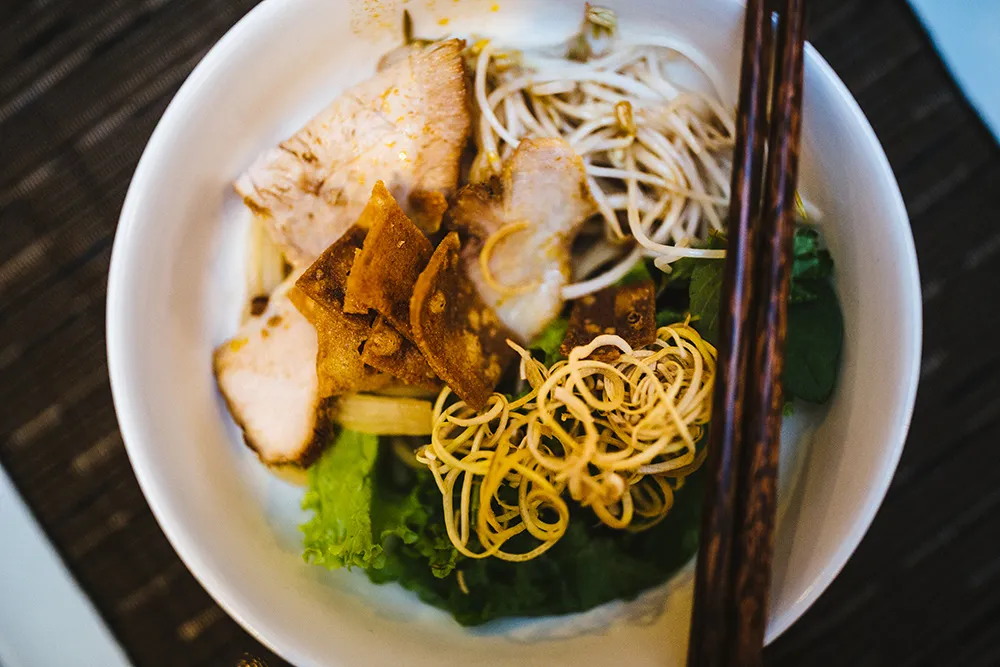 A bowl of Cao Lau noodles from Hoi An, a unique Vietnam Food Specialty with pork and herbs
A bowl of Cao Lau noodles from Hoi An, a unique Vietnam Food Specialty with pork and herbs
Try it: Thanh Cao Lau, 24 Thai Phien St, Hoi An.
Cơm Gà Hội An: Fragrant Chicken Rice
Chicken and rice is a simple concept, but in Hội An, it’s elevated to a delightful Vietnam Food Specialty known as Cơm Gà. This dish leverages the fresh, high-quality ingredients sourced from the surrounding countryside. Tender chicken meat is typically boiled and then shredded, mixed with a flavorful combination of fish sauce and onions, creating a savory topping for the rice.
The rice itself is often cooked with turmeric, chicken broth, and a touch of oil, giving it a beautiful golden hue and imparting a fragrant aroma. The dish is served with pickled shallots, radish, and a variety of fresh herbs on the side. Each cook may have slight variations, but classic Hội An chicken rice is often finished with a few leaves of Vietnamese coriander and hot mint, which provide a fresh, balancing counterpoint to the rich chicken and fragrant rice. After exploring the historic streets of Hội An, a plate of Cơm Gà is the perfect, comforting reward, showcasing another beloved Vietnam Food Specialty.
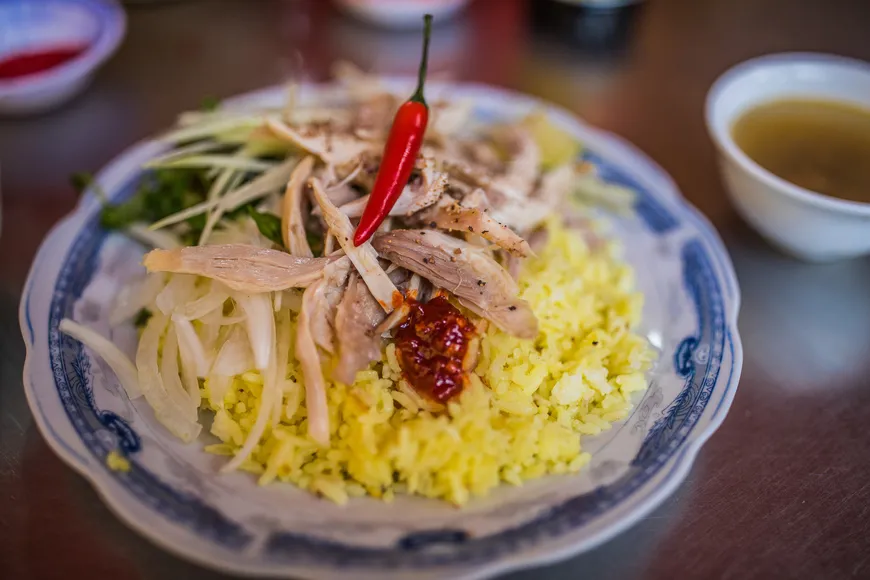 Plate of Com Ga, yellow chicken rice from Hoi An, a savory Vietnam Food Specialty
Plate of Com Ga, yellow chicken rice from Hoi An, a savory Vietnam Food Specialty
Try it: Com Ga Hien, 539 Hai Ba Trung St, Hoi An.
Mì Quảng: Noodles from Quang Nam
Mì Quảng is a captivating Vietnam Food Specialty from the Quang Nam province in Central Vietnam, offering a unique identity that blurs the lines between soup and noodle dish. Despite its elegant presentation, Mì Quảng is firmly rooted in street food culture. The vibrant yellow noodles are a signature element, their rich color derived from turmeric-infused broth, made flavorful with a touch of peanut oil.
Unlike traditional soups, Mì Quảng is served with only a small ladleful of this concentrated broth, just enough to moisten the noodles and ingredients. Toppings are varied and generous, ranging from shrimp and chicken to pork belly and even snakehead fish. The dish is typically served with fresh accouterments like sliced banana flowers, Vietnamese coriander, basil, and crispy bánh tráng me (toasted sesame rice crackers) for added texture and flavor. It’s a light yet incredibly satisfying noodle dish that perfectly represents the inventive spirit of Vietnam Food Specialties.
Try it: Quan Mi Quang Ba Mua, 95 Nguyen Tri Phuong, Chinh Gian, Thanh Khe, Da Nang.
Bánh Xèo: The Sizzling Crepe
Originating in the Mekong Delta, Bánh Xèo is a beloved Vietnam Food Specialty enjoyed widely across Southern and Central Vietnam. Part of the delight is watching it being made; the process is a captivating sensory experience. The rice flour and coconut milk batter hits the hot pan with a loud, satisfying crackle – “xèo” means sizzling, hence the name. As the crepe cooks, the skilled chef expertly swirls the pan to spread the batter thinly and evenly, creating crispy, golden edges.
The batter’s signature yellowish hue comes from the addition of turmeric. Often described as a savory pancake or crepe, Bánh Xèo is folded in half, enclosing a filling of boiled pork slices, minced pork, fresh bean sprouts, and shrimp. A well-made Bánh Xèo should be beautifully crispy, not soggy, and it’s best enjoyed immediately after coming off the skillet. Typically, you wrap pieces of the Bánh Xèo in large lettuce leaves or rice paper with various herbs before dipping into nước chấm. It’s a fun, interactive, and incredibly tasty way to experience Vietnam Food Specialties.
 A large, crispy Banh Xeo crepe filled with shrimp and vegetables, a popular Vietnam Food Specialty
A large, crispy Banh Xeo crepe filled with shrimp and vegetables, a popular Vietnam Food Specialty
Try it: Banh Xeo 46A, 46A D Dinh Cong Trang, District 3, Ho Chi Minh City.
Bún Chả: Hanoi’s Famous Grilled Pork with Vermicelli
Bún Chả soared to international fame when former U.S. President Obama shared a meal of it with Anthony Bourdain in Hanoi. However, this classic northern dish, a true Vietnam Food Specialty from the Old Quarter, has long been a lunchtime favorite among Hanoians. Around noon, the tantalizing aroma of seasoned pork grilling over hot charcoal fills the air, drawing hungry crowds to street-side stalls.
The dish is served components-style. It includes a portion of cold bún (rice vermicelli noodles), flavorful slices of grilled seasoned pork belly, and fragrant patties of grilled minced pork. These savory meats swim in a bowl of warm, fish sauce-based broth, which is slightly sweet and tangy. A generous mound of fresh herbs and various salad greens accompanies the dish. The typical way to eat Bún Chả is to dip small bundles of rice vermicelli and pieces of the grilled pork (patties and belly) into the broth bowl, enjoying alternating bites of noodles, meat, and fresh greens. It’s a perfectly balanced and utterly satisfying meal.
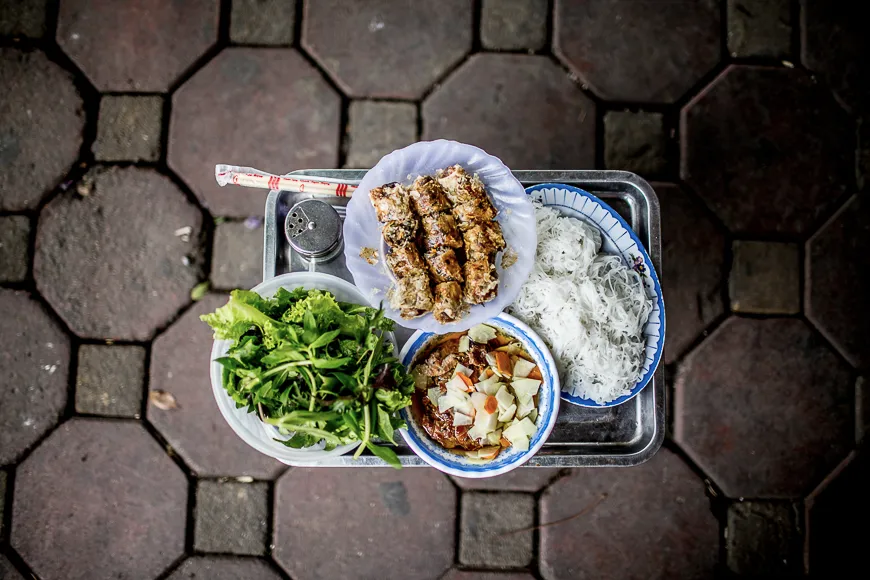 A spread of Bun Cha with grilled pork, vermicelli, herbs, and dipping sauce, a famous Vietnam Food Specialty from Hanoi
A spread of Bun Cha with grilled pork, vermicelli, herbs, and dipping sauce, a famous Vietnam Food Specialty from Hanoi
Try it: Bun Cha Huong Lien (also known as Bun Cha Obama), 24 Le Van Huu, Phan Dinh Ho, Hai Ba Trung, Hanoi.
Xôi: Versatile Vietnamese Sticky Rice
Xôi, or Vietnamese sticky rice, is a ubiquitous and versatile Vietnam Food Specialty that stands apart from other sticky rice preparations in the region. This dense, glutinous staple is enjoyed in both savory and sweet variations, making it suitable for any time of day. Xôi mặn, the savory version, is a popular and inexpensive breakfast option. It can be topped with various ingredients like fried shallots, dried shrimp, Vietnamese sausage (chả lụa), or even braised chicken or pork, offering a hearty start to the day.
For those with a sweet tooth, the options for Xôi ngọt are seemingly endless, with over 20 different types. These sweet versions often incorporate ingredients like mung beans, corn, peanuts, or various fruits, and are sometimes drizzled with coconut milk or sugar. A particularly visually stunning sweet variety is Xôi ngũ sắc, the five-colored sticky rice. Pigmented using natural plant extracts, it presents a beautiful swirl of purple, green, red, yellow, and white rice, making it a feast for the eyes as well as the palate and a must-try Vietnam Food Specialty.
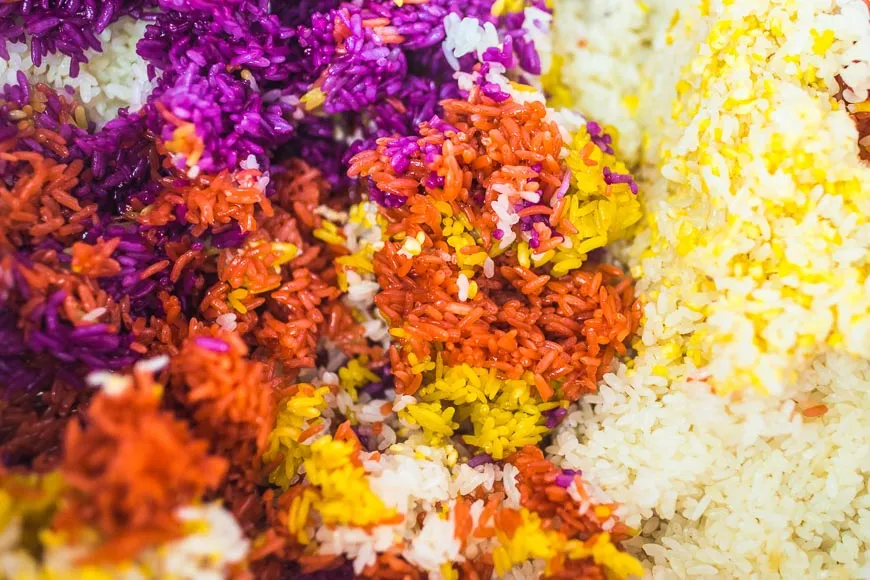 Colorful Xoi, Vietnamese sticky rice, a versatile Vietnam Food Specialty
Colorful Xoi, Vietnamese sticky rice, a versatile Vietnam Food Specialty
Try it: Xoi Yen, 35B Nguyen Huu Huan, Ly Thai To, Hoan Kiem, Hanoi.
Bánh Bèo: Delicate Steamed Rice Cakes
Bánh Bèo are delicate, bite-sized steamed rice cakes that serve as a popular appetizer or snack in Central Vietnam, particularly in Hue. These little discs, often served in small saucers, are akin to Vietnamese tapas, perfect for grazing. Each soft, slightly chewy cake is traditionally topped with a spoonful of creamy mung bean paste and sprinkled with finely toasted shrimp.
The cakes are then typically garnished with either crunchy croutons or the more indulgent tép mỡ, crispy fried pork fat. At the center of a well-made Bánh Bèo, you’ll often find a slight indentation, a sign that it was perfectly steamed. These delightful cakes are typically enjoyed by adding a bit of nước chấm (dipping sauce) directly into the saucer or dipping the cake itself. Their simple elegance and delightful texture make them a charming Vietnam Food Specialty.
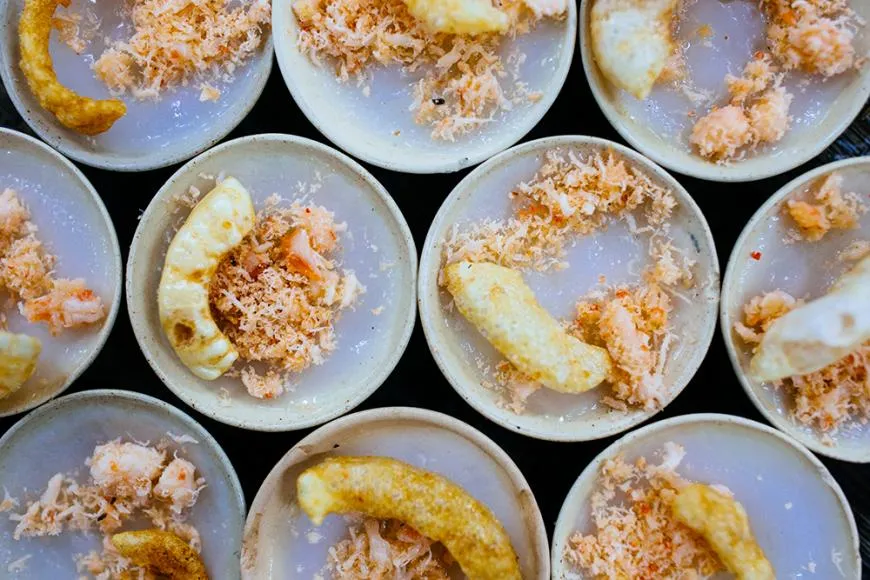 Small Banh Beo steamed rice cakes topped with shrimp and herbs, a delicate Vietnam Food Specialty
Small Banh Beo steamed rice cakes topped with shrimp and herbs, a delicate Vietnam Food Specialty
Try it: Quan Hanh, 11 Pho Duc Chinh (South Bank), Hue.
Bún Riêu: Tomato and Crab Noodle Soup
Bún Riêu is a vibrant and flavorful Vietnam Food Specialty characterized by the wonderful interplay between rich crab and tangy tomato. This hearty soup boasts a delightful acidity that sets it apart. The main components include slippery bún (rice vermicelli), fresh crab meat, soft blocks of tofu, and stewed tomatoes, all bathing in a flavorful broth.
Creating an authentic bowl of Bún Riêu is a labor of love. After separating the meat, the crab shells are often pounded into a paste using a mortar and pestle, then strained to form the base of the broth, imparting a deep, savory crab flavor. Floating within the soup are soft clusters of minced crab combined with ground pork and egg, which have a light, melt-in-your-mouth texture. The result is a complex, comforting soup that is a cherished Vietnam Food Specialty.
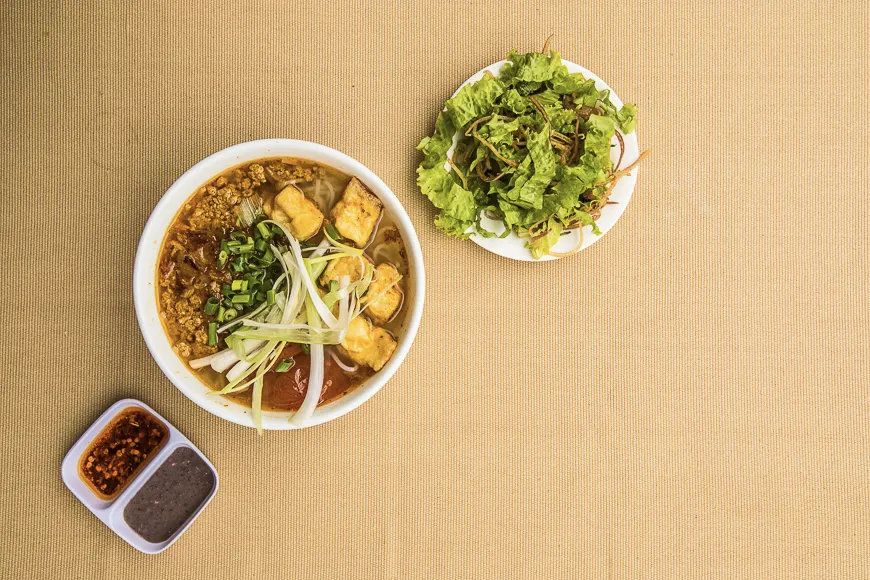 A bowl of Bun Rieu, tomato and crab noodle soup, a flavorful Vietnam Food Specialty
A bowl of Bun Rieu, tomato and crab noodle soup, a flavorful Vietnam Food Specialty
Try it: Bún Riêu Cua Thanh Hồng, 42 Hòa Mã, Ngô Thì Nhậm, Hai Bà Trưng, Hanoi.
Gỏi Cuốn: Fresh Spring Rolls
Gỏi Cuốn, or fresh spring rolls, are a refreshing and “action-packed” Vietnam Food Specialty bursting with freshness. These rolls are made by wrapping a variety of ingredients in softened sheets of translucent rice paper (bánh tráng). Inside, you’ll typically find a vibrant stack of leafy greens, aromatic mint and coriander, sometimes rice vermicelli noodles, and a form of protein. Often, a stalk of garlic chive is included, poking out from the ends of the snugly wrapped roll.
The most common and popular variety features a delightful surf and turf combination of tender pork tenderloin and plump, shelled shrimp. Gỏi Cuốn are not fried, making them a lighter option compared to their fried counterparts (nem rán or chả giò). They are typically served with a dipping sauce, either a rich, nutty hoisin sauce topped with crushed peanuts or the classic nước chấm. Simple, fresh, and incredibly satisfying, Gỏi Cuốn are a perfect example of the clean flavors found in many Vietnam Food Specialties.
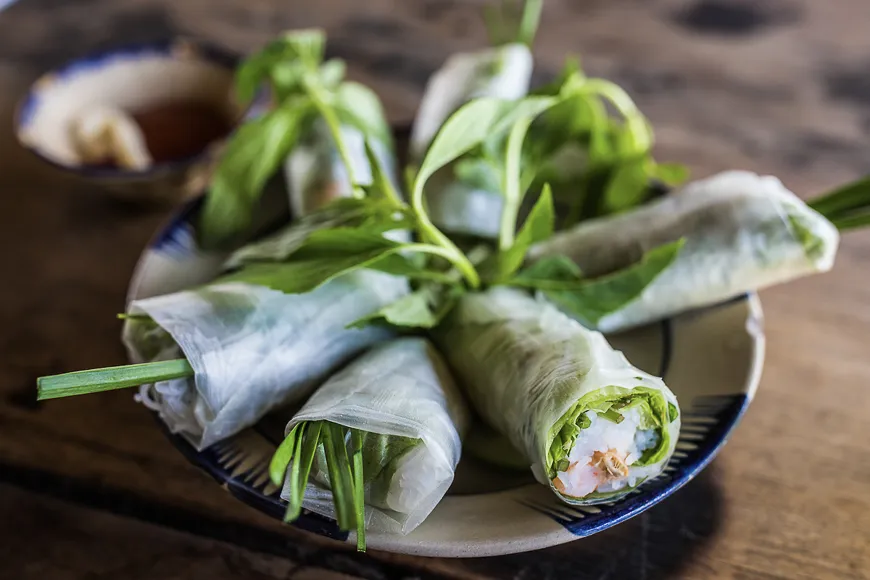 Fresh Goi Cuon spring rolls with shrimp and herbs, a healthy Vietnam Food Specialty
Fresh Goi Cuon spring rolls with shrimp and herbs, a healthy Vietnam Food Specialty
Try it: Quan An Ngon, 18 Phan Boi Chau, Hoan Kiem, Hanoi.
Bánh Căn: Mini Savory Pancakes
Bánh Căn are delightful bite-sized savory pancakes, a cherished Vietnam Food Specialty particularly popular in the south-central region. These crispy little cakes are made from a simple rice batter, often mixed with green onions, and cooked in special earthenware molds over an open flame. A cracked quail egg is frequently added to the batter as it cooks, creating a satisfying little bite.
Traditionally served plain, Bánh Căn today are commonly topped with ingredients like shrimp or pork before cooking. They are served with a dipping sauce, often a bowl of broth enriched with green onions and sometimes containing small meatballs. Each bite offers a wonderful contrast between the crispy exterior and the soft, eggy interior, making Bánh Căn an addictive and flavorful Vietnam Food Specialty that’s perfect as a snack or appetizer.
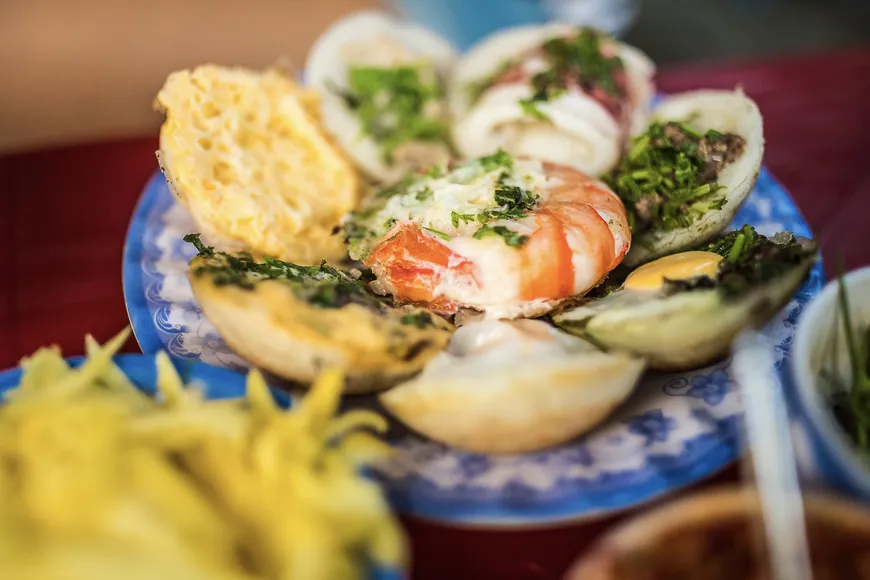 Banh Can mini savory pancakes cooked in molds, a popular Vietnam Food Specialty
Banh Can mini savory pancakes cooked in molds, a popular Vietnam Food Specialty
Try it: Phan Rang, 106 Trương Định, Phường 9, Quận 3, Ho Chi Minh City.
Hủ Tiếu Nam Vang: Southern Noodle Soup
Hủ Tiếu Nam Vang is a standard and beloved street food item in Southern Vietnam, representing the Vietnamese version of Cambodia’s kuy teav and Thailand’s guay tiew. This versatile Vietnam Food Specialty is typically a bowl of noodles served in two main styles: wet (nước), with broth, or dry (khô), where the noodles are dressed with sauce and the broth is served separately on the side.
The signature broth for Hủ Tiếu is usually opaque and made from pork bones, providing a rich base. The definitive and most popular rendition is Hủ Tiếu Nam Vang, named after Phnom Penh (Nam Vang in Vietnamese). This version is often more complex, calling for ingredients like pork on the bone, boiled liver, a quail egg, and shrimp. For the less adventurous, you can request to omit ingredients like congealed pork blood chunks, which sometimes appear. The peppery broth, often speckled with chopped green onions, also has a noticeable sweetness, typically achieved by adding rock sugar.
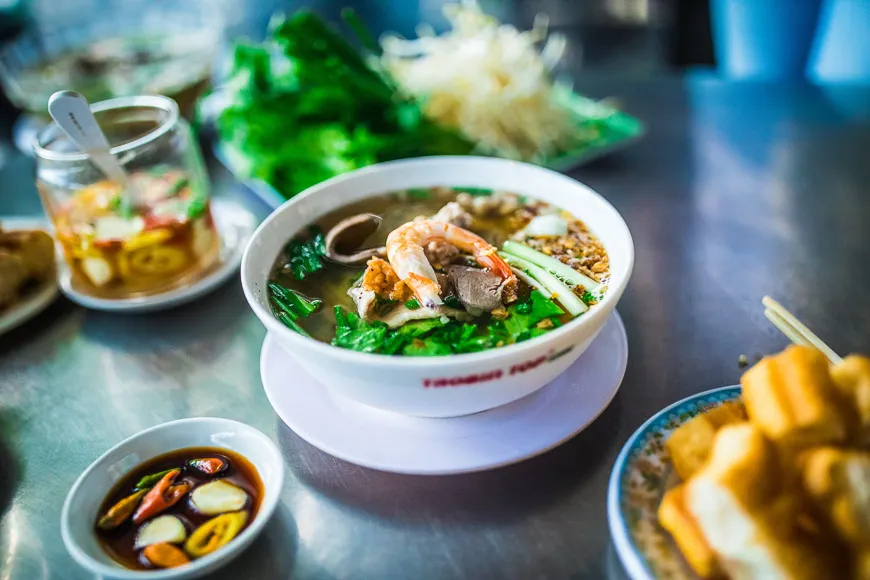 A bowl of Hu Tieu Nam Vang noodles, a popular Southern Vietnam Food Specialty
A bowl of Hu Tieu Nam Vang noodles, a popular Southern Vietnam Food Specialty
Try it: Hu Tieu Co Huong, 152/7/2 Ly Chinh Thang, Ward 7, District 3, Ho Chi Minh City.
Chả Cá: Dill and Turmeric Fish
Chả Cá is a distinct and uniquely northern Vietnam Food Specialty, particularly associated with Hanoi. It’s a dish that offers a captivating contrast of flavors, textures, and colors. Flaky chunks of white fish, often Hemibagrus or Catfish, are marinated in a blend that includes turmeric, which gives the fish a pale yellow hue. This marinated fish is then sautéed in butter on a hot skillet right at your table.
Generous amounts of fresh dill and green onions are added to the skillet, wilting slightly and blanketing the fish. The fresh herbs perfume the dish and create a striking visual with the yellow fish. Chả Cá is typically served with rice vermicelli noodles (bún), roasted peanuts, and a dipping sauce (often mắm tôm, a fermented shrimp paste, though nước chấm is also common). It’s a very interactive and aromatic dining experience, considered a must-try Vietnam Food Specialty when in the capital.
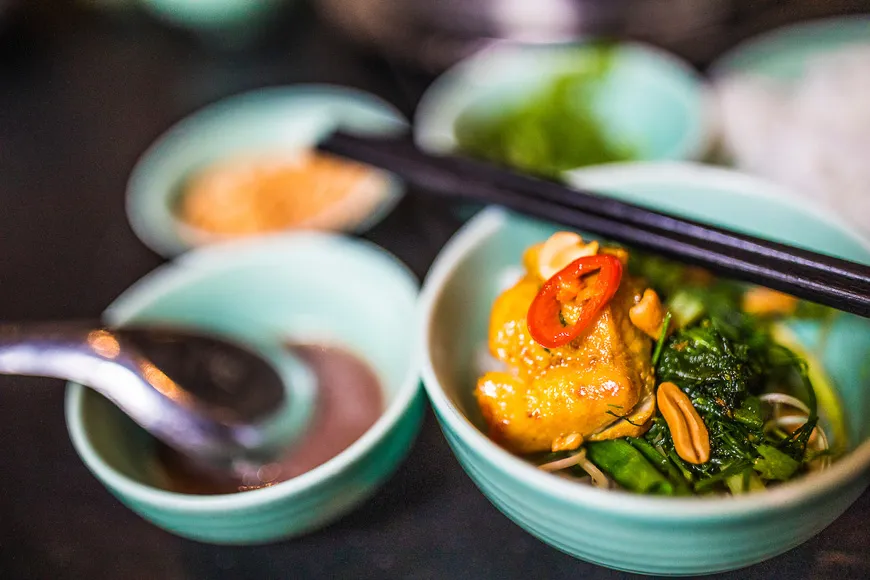 Cha Ca, fish marinated in turmeric and dill, cooked tableside, a unique Vietnam Food Specialty from Hanoi
Cha Ca, fish marinated in turmeric and dill, cooked tableside, a unique Vietnam Food Specialty from Hanoi
Try it: Cha Ca Thang Long Restaurant, 19-21-31 Duong Thanh, Hoan Kiem, Hanoi.
Nộm Hoa Chuối: Banana Flower Salad
Nộm Hoa Chuối, or banana flower salad, is a refreshing and visually stunning Vietnam Food Specialty. It’s a vibrant salad made from finely shredded banana blossom (the large, purplish bud from a banana tree), typically tossed with pickled carrots, fresh coriander, sometimes lotus root, and shredded cabbage. Depending on the season, ingredients like pomelo or julienned green mango or papaya might be added, bringing seasonal freshness.
While often enjoyed as a vegetarian dish, it can also be made with the addition of shredded chicken, beef, or shrimp. The salad is bound together with a flavorful nước chấm dressing, providing a balance of sweet, sour, salty, and spicy notes. It’s often garnished with crushed peanuts for crunch and bird’s eye chili for a kick. A final squeeze of lime before eating adds a bright, zesty punch. This salad showcases the Vietnamese ability to turn simple plant ingredients into a complex and delicious dish.
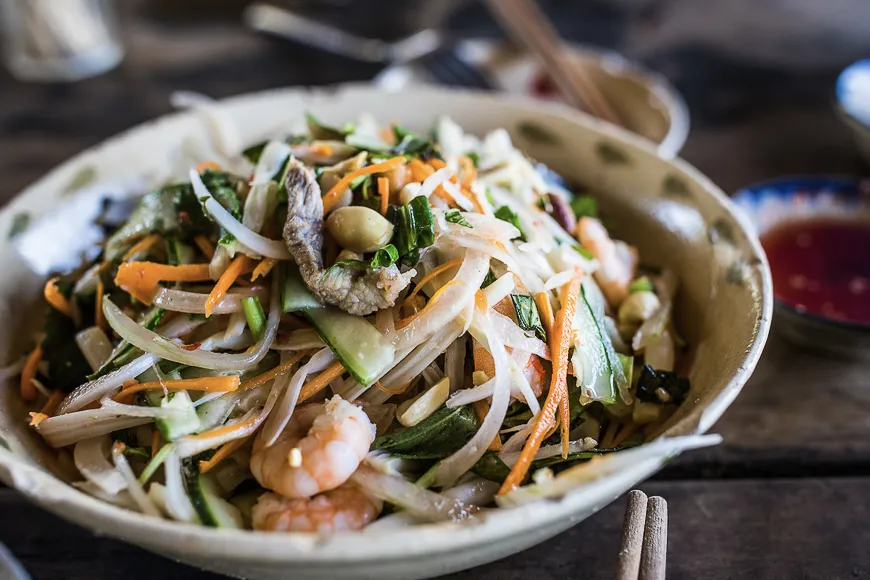 A vibrant Nom Hoa Chuoi banana flower salad, a refreshing Vietnam Food Specialty
A vibrant Nom Hoa Chuoi banana flower salad, a refreshing Vietnam Food Specialty
Try it: Mountain Retreat, 36 Le Loi, Ben Nghe, District 1, Ho Chi Minh City.
Bánh Cuốn: Steamed Rice Rolls
Bánh Cuốn are delicate and savory steamed rice rolls, a beloved Vietnam Food Specialty often enjoyed for breakfast. These rolls are made by steaming a thin batter of rice flour on a cloth stretched over a pot of boiling water, similar to making a crepe. The resulting large, round, translucent sheet is then gently lifted and typically filled with a mixture of seasoned minced pork and finely chopped wood-ear mushrooms.
Once filled, the sheets are carefully folded or rolled and then often cut into smaller segments. Bánh Cuốn are always made fresh to order, ensuring their soft, slightly chewy texture. They are commonly topped with crispy fried shallots and served with a side bowl of a light fish sauce-based dipping sauce, often containing a piece of Vietnamese pork sausage (chả lụa). Adding fresh herbs to your dipping sauce or directly to the rolls is common practice, brightening the flavors and adding more complexity to this simple yet delightful dish.
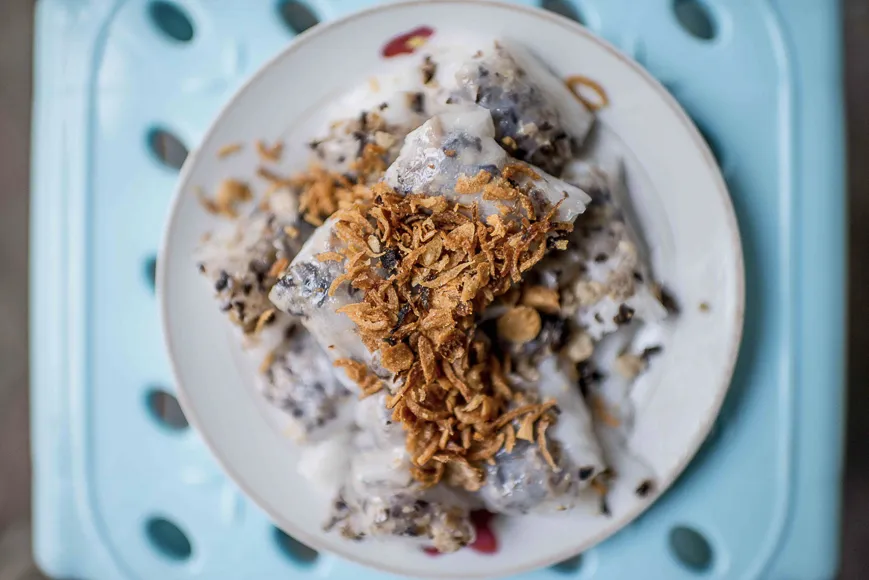 Banh Cuon steamed rice rolls with minced pork and mushrooms, a delicate Vietnam Food Specialty
Banh Cuon steamed rice rolls with minced pork and mushrooms, a delicate Vietnam Food Specialty
Try it: Bánh Cuốn 101 Bà Triệu, 147 Triệu Việt Vương, Hai Bà Trưng District, Hanoi.
Bún Chả Cá: Fish Cake Noodle Soup
Bún Chả Cá is a versatile Vietnam Food Specialty with many variations depending on the specific region you find it. At its core, the dish consists of spaghetti-like rice vermicelli noodles (bún) and fish cakes (chả cá), served in a flavorful broth and accompanied by fresh herbs. The “local twist” is what makes each regional version unique.
For example, Bún Chả Cá Nha Trang from the central coastal city incorporates bouncy squid cakes alongside the fish cakes, and the broth is often light, slightly sour, and features tomatoes and dill. Other variations might include different types of fish cakes, broths, or accompanying vegetables. Regardless of the specific style, Bún Chả Cá offers a light yet satisfying noodle soup experience, showcasing the fresh flavors of seafood in Vietnamese cuisine. It’s typically served with a side of greens and a squeeze of lime to brighten the flavors.
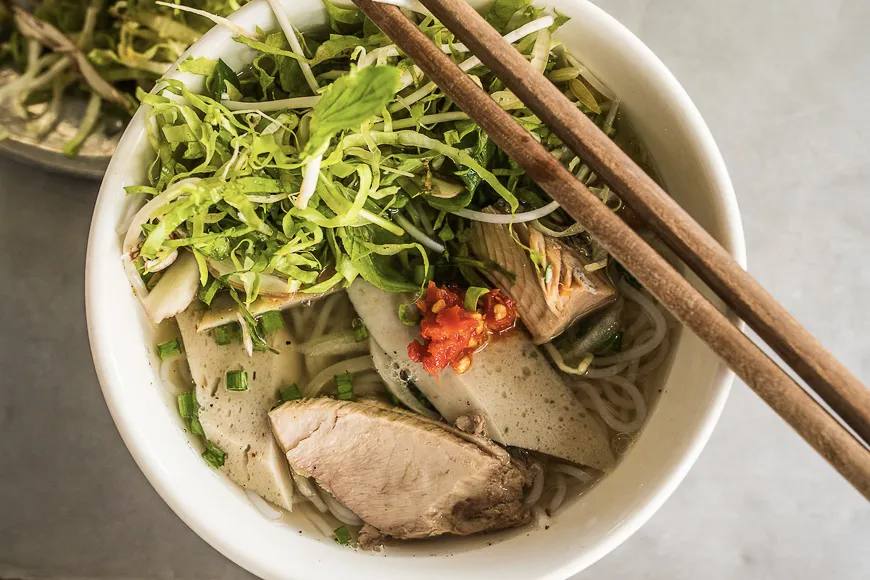 Bun Cha Ca Nha Trang, fish cake noodle soup from Nha Trang, a coastal Vietnam Food Specialty
Bun Cha Ca Nha Trang, fish cake noodle soup from Nha Trang, a coastal Vietnam Food Specialty
Try it: Bún Cá Mịn 170 Bạch Đằng, Tân Lập, Nha Trang.
Bún Bò Cuốn Lá Lốt: Grilled Beef in Betel Leaves
Bún Bò Cuốn Lá Lốt, or grilled beef wrapped in betel leaves, is a distinct and aromatic Vietnam Food Specialty particularly popular in the South. This dish features a flavorful mixture of minced beef, garlic, and shallots, which is then rolled inside a lá lốt (betel) leaf, resembling a small cigar. These rolls are traditionally grilled over charcoal, which imparts a smoky aroma and creates a slightly seared, crispy outer layer from the leaf, sealing in the juicy meat.
The result is a burst of savory, slightly peppery flavor from the betel leaf and the seasoned beef. Bò lá lốt can be enjoyed in several ways: directly off the grill as a snack, served alongside rice vermicelli noodles (bún), or rolled up further in rice paper with a variety of fresh herbs and vegetables. The playful combination of textures and the unique flavor imparted by the betel leaf, especially when dipped in a spicy fish sauce, make this a must-try Vietnam Food Specialty for meat lovers exploring the country.
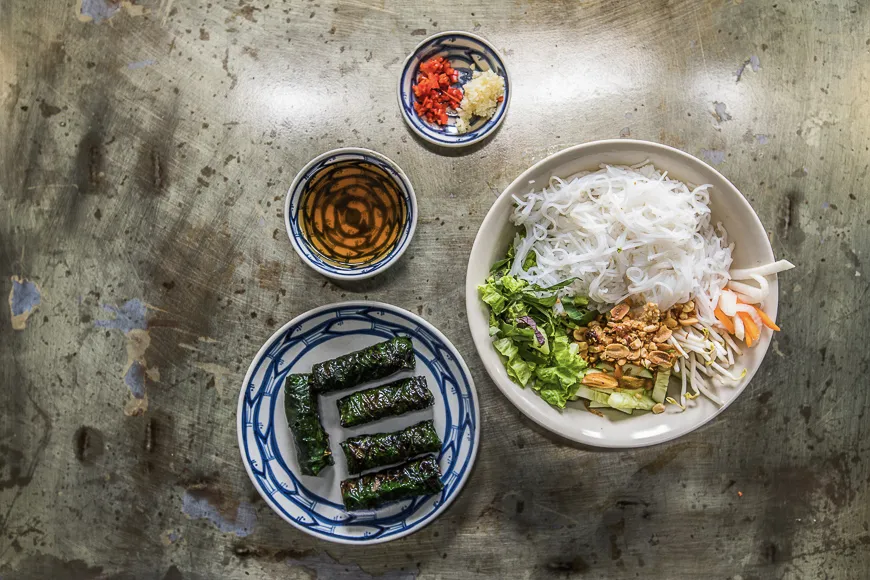 Grilled beef wrapped in betel leaves (Bo La Lot), a flavorful Vietnam Food Specialty
Grilled beef wrapped in betel leaves (Bo La Lot), a flavorful Vietnam Food Specialty
Try it: Cô Liêng, 321 Võ Văn Tần, District 3, Ho Chi Minh City.
Chè: Sweet Soups and Puddings
Chè refers to a broad category of Vietnamese sweet soups, puddings, or dessert drinks. This is a diverse and delightful Vietnam Food Specialty, served either hot or cold, depending on the ingredients and the weather. Cold Chè is particularly popular in the hot climate, often featuring a variety of jellied ingredients, beans, seeds, and tropical fruits such as bananas, mangoes, and longan, typically served with a generous drizzle of coconut cream and crushed ice.
Eating Chè is always a textural adventure; you might encounter chewy tapioca pearls, soft beans, crunchy coconut shreds, lotus seeds, various types of jelly, and refreshing fruit pieces all in one bowl or glass. One visually appealing and popular type is Chè ba màu, the “three-colored” dessert, sometimes affectionately called the rainbow dessert. This layered spectacle typically features distinct stripes of red beans, mashed mung beans (often green or yellow), and pandan jelly, topped with crushed ice and creamy coconut milk. Chè offers a refreshing and often surprising sweet conclusion to a Vietnamese meal, or a delightful snack any time.
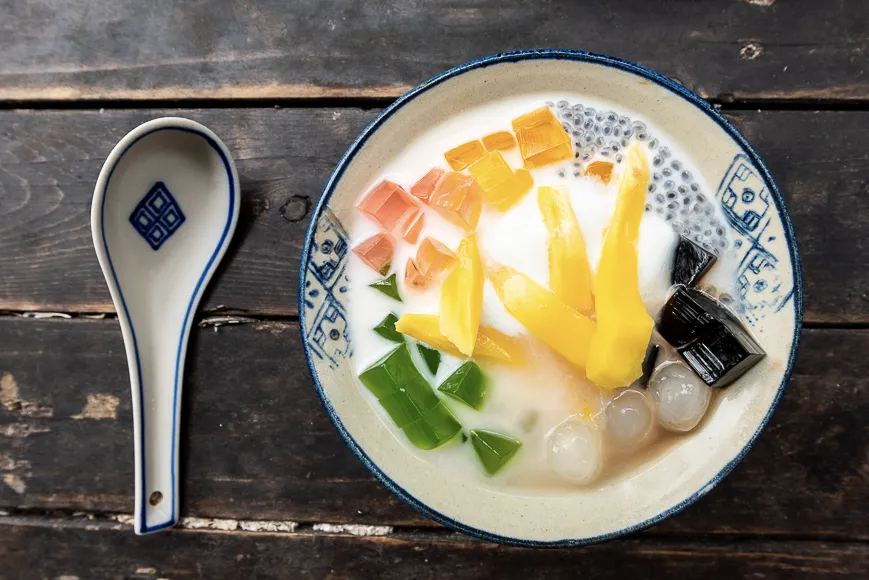 A glass of colorful Che, Vietnamese sweet dessert soup, a refreshing Vietnam Food Specialty
A glass of colorful Che, Vietnamese sweet dessert soup, a refreshing Vietnam Food Specialty
Try it: Che 95, 95 Hang Bac, Hoan Kiem, Hanoi.
The Cultural Heartbeat of Vietnam Food Specialties
Beyond their delicious flavors, Vietnam Food Specialties are deeply interwoven with the country’s culture, history, and social fabric. Food is not just sustenance; it’s a form of communication, a way to express hospitality, respect, and connection. Meals, especially family meals, are central to Vietnamese life, a time for gathering and sharing. The communal nature of many dishes, served family-style, encourages interaction and bonding.
Street food culture is another vital aspect of Vietnam Food Specialties. Sidewalks come alive with vendors and small eateries, offering everything from a quick bánh mì to a steaming bowl of phở or a sizzling bánh xèo. This vibrant scene is where many authentic flavors are found, reflecting the accessibility and everyday importance of delicious food for everyone. Festivals and special occasions also feature specific traditional dishes, each carrying its own symbolism and historical significance.
Exploring Vietnam Food Specialties means engaging with these cultural dimensions. It’s understanding why specific ingredients are used in certain regions, learning about the history behind a dish like Bún Bò Huế (linked to royal cuisine), or appreciating the communal ritual of sharing a hot pot. It’s a holistic experience that nourishes both the body and the soul.
Planning Your Culinary Adventure: Tips for Enjoying Vietnam Food Specialties
Embarking on a journey to explore Vietnam Food Specialties is incredibly rewarding. Here are a few tips to make the most of your culinary adventure:
- Be Adventurous: Don’t be afraid to try street food. Many of the most authentic and delicious Vietnam Food Specialties are found at street stalls and local markets. Look for places with a steady stream of local customers – that’s usually a good sign.
- Master Chopsticks (or Ask for a Spoon): Most dishes are eaten with chopsticks and a spoon. Practice makes perfect, but it’s completely fine to ask for a spoon if needed, especially for soups.
- Learn Basic Phrases: Knowing “Cảm ơn” (thank you) and the name of the dish you want can go a long way. Pointing is also universally understood!
- Embrace the Herbs: Vietnamese food is known for its abundance of fresh herbs. Don’t hesitate to add them to your soups or rolls; they add incredible freshness and complexity.
- Spice Levels Vary: While Central Vietnamese food is spicier, chili is often provided separately. You can usually control the heat level yourself.
- Stay Hydrated: Vietnam can be hot and humid. Drink plenty of water or local iced tea (trà đá) which is often offered free with meals.
- Food Tours: Consider taking a food tour. It’s a fantastic way to learn about the history of dishes, discover hidden gems, and navigate local markets with expert guidance.
Frequently Asked Questions About Vietnam Food Specialties
What are the most famous Vietnam Food Specialties?
Phở and Bánh Mì are arguably the most internationally famous, but other essential Vietnam Food Specialties include Bún Chả, Cơm Tấm, Bún Bò Huế, and Bánh Xèo.
Is Vietnamese food healthy?
Vietnamese cuisine is generally considered healthy. It emphasizes fresh ingredients, lean proteins (fish, chicken, pork), and a large amount of fresh herbs and vegetables. Many dishes are steamed or grilled rather than fried.
What makes Vietnamese food different from other Asian cuisines?
Vietnamese food often features a balance of sweet, sour, salty, and spicy flavors. It heavily utilizes fresh herbs, fish sauce (nước mắm), and has distinct regional variations. The influence of French colonialism is also seen in dishes like Bánh Mì and Bánh Xèo.
Can I find vegetarian Vietnam Food Specialties?
Yes, vegetarian (chay) food is widely available in Vietnam, particularly influenced by Buddhist practices. Many classic dishes like Phở, Bánh Xèo, and Gỏi Cuốn can be prepared in vegetarian versions using tofu and vegetables.
What are some unique ingredients in Vietnam Food Specialties?
Key ingredients include fish sauce (nước mắm), shrimp paste (mắm tôm), lemongrass, star anise, cinnamon, mint, coriander, basil, rice noodles, and various types of rice paper. Many dishes also feature fresh vegetables and herbs unique to the region.
Conclusion: A Culinary Journey Awaits
Exploring Vietnam Food Specialties is an adventure for the senses and a profound way to connect with the country’s vibrant culture and history. Each dish, from a simple bowl of Phở to a complex Bún Bò Huế, tells a story of tradition, regional identity, and the Vietnamese people’s passion for fresh, flavorful food. Stepping off the beaten path to discover local favorites and understand the cultural context behind what you eat transforms a simple meal into a memorable experience.
So, as you plan your travels or seek new culinary horizons, let the world of Vietnam Food Specialties beckon you. Embrace the opportunity to taste the regional differences, savor the intricate flavors, and understand how food serves as a vital thread connecting the past, present, and future in Vietnam. It’s a journey guaranteed to be rich in flavor and unforgettable moments.
